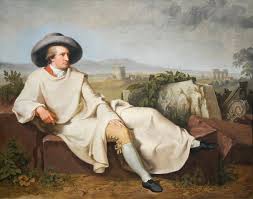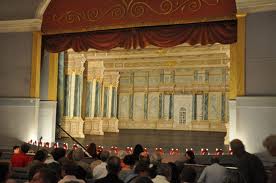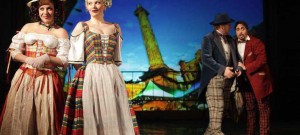Weimar and its environs illuminate the complex history of Germany. I went last weekend with my wife and some friends to Weimar, the home of the great German artist, Johann Wolfgang von Goethe, his contemporary, Friedrich Schiller, and for many years the domain of Franz Liszt. When we first arrived, we left the city, full of remarkable eighteenth and nineteenth century houses and buildings, and drove a short distance to see Buchenwald, one of the Nazis most infamous concentration camps. Vast and empty with only numbers to indicate the buildings that housed various groups of prisoners (including to my surprise some POWs), Buchenwald is as horrible as one would expect. To the Germans’ eternal credit, they have detailed in German and English everything that happened at the camp. Open to the public every day in the week, the German government neither hid nor sanitized anything. Each of us became more and more moved, and indeed silent, as we visited buildings in the camp. We went on a very dark, gray day and before we left it poured rain, appropriate to our reactions. The word Buchenwald speaks to the beautiful forest around the camp, which to me added to the horror. All those in the camp saw a bucolic landscape of rolling hills as they underwent imprisonment and torture.
The Germans of today want everyone to see and feel the horror of the Nazi period. In Berlin, for instance, at the spot of the SS headquarters, there is a museum called Topography of Terror, open ten hours a day, seven days a week, and free to the public. Everything the SS did, how the Nazis got into power and the horrors they perpetrated is clearly laid out in German and English. The museum, filled with young Germans, teenagers and grade schoolers, as was Buchenwald, testified to their intentions. Guides explained what visitors didn’t read. It might be a good idea for us to document for our children some of what we have done that shouldn’t have happened.
The trip was certainly not only about Buchenwald. Goethe, the most revered German literary figure, lived and died in Weimar, and his house can be seen exactly as it was when he died, in March of 1832. Goethe’s novel Werther and his play Faust stand among the most influential literary works of Western civilization. On this trip, I learned that Goethe was very close in his range of activities to his American contemporary Thomas Jefferson in the breadth of his knowledge and accomplishments. He was an architect, a painter, a remarkable collector, a politician (or at least a man who held political positions), a theater director, a designer, and surprisingly to me a General Director for some years of a very interesting theater. He was also a devoted husband and father, a leader in the community of Weimar, a favorite of the local Prince, and just about anything else one might imagine. His house showed his theory of colors—what was restful, what was stimulating, what was appropriate for a dining room or a study. Everything in the house is as it was, including his great library; sadly, the latter is behind a gate, great for the books but frustrating for the visitor. One can also see the room and the very bed in which he expired.
He was an architect, a painter, a remarkable collector, a politician (or at least a man who held political positions), a theater director, a designer, and surprisingly to me a General Director for some years of a very interesting theater. He was also a devoted husband and father, a leader in the community of Weimar, a favorite of the local Prince, and just about anything else one might imagine. His house showed his theory of colors—what was restful, what was stimulating, what was appropriate for a dining room or a study. Everything in the house is as it was, including his great library; sadly, the latter is behind a gate, great for the books but frustrating for the visitor. One can also see the room and the very bed in which he expired.
Next door is a museum with more materials on Goethe, more of what he collected, more of what he did. There is also in Weimar a great library named after his wife with one of the greatest collections of books in Europe. The original Faust is there. A few years ago old electric wiring set off a fire that burned a large number of books. As the fire blazed, some of the crowd watching ran into the burning building and saved many books by hurling them, smoking, from the building. When the fire was put out, the call went out for money to restore the library and save damaged books. Within three months the millions of Euros needed had been contributed from all over Germany; immediately other old libraries in the country were thoroughly redone electrically, and the damaged library now is restored completely.
Seeing Goethe’s work in Weimar was not all. We drove to a very small town, really a village, called Bad Lauchstaedt about an hour away. I have found that few Germans interested in the arts know about the amazing theater there, one built to designs by Goethe. At the beginning of the nineteenth century a neighboring principality declared theater to be an abomination, and closed all the theaters. There was a small theater in this village; the Prince in Weimar decided that one way to bring in badly needed money—Napoleon was threatening—would be to enlarge the theater so that those who had been denied theater could come there as could the people in his domain. Goethe designed the new theater and starting in 1803 built and ran it for about a decade. It opened with Mozart’s Idomeneo and also offered La Clemenza di Tito, plus a lot of plays.
 The theater kept producing for some years, and Richard Wagner, newly assigned as Kapellmeister in the nearby larger town of Magdeburg, reputedly conducted opera for the first time, Die Zauberfloete, there in 1834. The theater seats 600, and all the working parts of the stage—everything that caused scenery movement onstage, plus the structure of the traps and the lifts, were worked out under Goethe’s supervision and in some cases his design. In the theater itself, because money was scarce, stretched canvas over curved wood (the creation of a domed wooden ceiling had at that time recently been realized) made the ceiling. The floor of the auditorium was slightly raked, and there was a wrap-around balcony. It is thought that some forty years later Wagner modeled some of the Bayreuth Festspielhaus after what he had experienced at the Bad Lauchstaedt Theater.
The theater kept producing for some years, and Richard Wagner, newly assigned as Kapellmeister in the nearby larger town of Magdeburg, reputedly conducted opera for the first time, Die Zauberfloete, there in 1834. The theater seats 600, and all the working parts of the stage—everything that caused scenery movement onstage, plus the structure of the traps and the lifts, were worked out under Goethe’s supervision and in some cases his design. In the theater itself, because money was scarce, stretched canvas over curved wood (the creation of a domed wooden ceiling had at that time recently been realized) made the ceiling. The floor of the auditorium was slightly raked, and there was a wrap-around balcony. It is thought that some forty years later Wagner modeled some of the Bayreuth Festspielhaus after what he had experienced at the Bad Lauchstaedt Theater.
In the first decade of the twentieth century modern machines replaced the wooden mechanisms under the stage. After World War II those in charge of the theater decided that since the theater was undamaged and Goethe’s original drawings were available, they would recreate them.
Performances take place during the summer with the performers and orchestra coming from the nearby Halle Opera. We attended Friedrich von Flotow’s Martha, a light German work which I had last heard in 1961 at the Metropolitan. It has two really great numbers: “The Last Rose of Summer” (repeated in parts or completely eight times!) and the tenor aria, “Ach, ich fromm” or “M’appari.”
The pit allowed for only two rows of musicians; brass and winds were relegated to the sides behind the conductor. The stage is about eight meters or around 18 feet wide and somewhat shallow. For this performance the chorus was sometimes on stage, sometimes in the balcony. Kay Stromberg conducted superbly. The orchestra had good sound, good volume, and his tempi were excellent. Staging by Michael McCaffery simply allowed the plot to happen with one final original twist.
In Martha two English noblewomen bored with their life and not at all interested in their suitors or their protector decide to go as maids to the country fair. At the fair yeomen can purchase the service of village maids for a year. The two women are bought by two workmen, a tenor, Lionel (whose parentage is unknown), and a baritone Plunkett. Predictably the women have no intention of working and that night a somewhat prissy noblemen, Lord Tristan, spirits them away from the house where the men live. Angry and upset the men have paid for the girls and expect them to be indentured servants. Additionally both have fallen for their maids—the tenor Lionel for Lady Harriett, who calls herself Martha, and her attendant Nancy. The plot works out as one might predict. The men see their workers, now back to being noblewomen; when they claim them, they are disciplined for being absurd; the women relent, Lionel’s ring proves him to be the son of a nobleman, and the four are united. In this production, however, the director made Lionel still angry at Martha at the end, not quite sure that he would accept her because of the trick she played on him. A good Cosi-like twist.
The best singer was the Lionel, Ralf Simon, who sang his well-loved aria superbly. After a slow start his light lyric tenor proved up to the role. Sandra Maxheimer, as Nancy, delivered a lovely if small mezzo soprano, and Asgeir Pall Agustsson a bluff, hearty Plunkett. Marie Friederike Schoeder had a great smile and good looks, but did not find Lady Harriett (Martha) comfortable vocally. Pitch in her high register often lacked accuracy. Ki-Hyun Park sang and acted a properly smarmy Lord Tristan. After the performance a theater official gave a thirty-minute talk on the theater and took us on a tour of all the backstage equipment. It was astonishing how all the wooden equipment moved so perfectly and quietly.
I should add that a gorgeous park surrounds the theater. It was the right bucolic atmosphere both for Martha and a performance in an amazing theater, one that is very worth a visit. It’s about an hour and a half from Berlin by car.
As we drove back to Berlin, moving through a lot of rural roads until we hit the Autobahn, it was hard not to dwell on the complexity of the German experience—the twelve horrible years of the Nazis against literally centuries of great artists, painters and philosophers. Great art or artists do not erase or excuse evil, but they do in the end conquer.

“including to my surprise some POWs…” The Nazis murdered 3 million Soviet POWs. The purpose of invading the East was to exterminate the Slavic people and colonize their lands. So there was no reason to keep the POWs alive. A good illustration of the genocidal policies directred toward the Slavs was the siege of Lenningrad.
Another problem was that the Wehrmacht overran so much of the Soviet Union in the first year of the war that they had no means of keeping the POW population of 3 million alive, expect as slaves. In the town of Oberndorf, near where I live, about 7000 POW slaves were worked to death in the Mauser armaments factory. Most were Russians.
Due to the propaganda and half-histories of the Cold War, most people do not know that the Soviets faced a war of extermination. It is only that fact that caused the Soviets to fight so hard. Twenty-seven million Soviets died in the war. By comparison the USA lost about 300,000 fighting both Japan and Germany – about 1/90th the amount. Or about 1/180th the amount fighting the Germans.
The Soviets lost a million men at the Battle of Stalingrad alone. By contrast, there were only 1500 US causalities in the D-Day invasion – 1/666th the amount. One in every 4 Soviet soldiers was killed in the war, while the US military only lost 1 in 100.
In reality, it was essentially a German-Soviet War while the US, Britain, and France stood on the side-lines until the outcome was a forgone conclusion. Unfortunately, Americans are so brainwashed that these obvious historical facts outrage them. We didn’t defeat the Nazis, the Soviets did. We contributed to the work, but only a relatively small part. So yes, Americans are even surprised there were POWs in concentration camps. Our sense of the history of WWII has been so distorted. I wonder when the obvious and documented history will eventually become more known. For now, we can only expect blustering and false denial when these facts are mentioned.